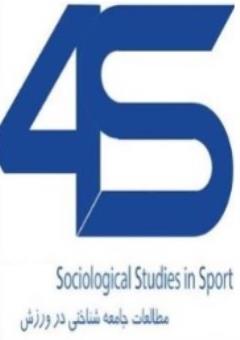Presenting a model of reducing gender inequality in sports from a sociological perspective based on the grounded theory
Subject Areas :
Marzieh Movafagh
1
![]() ,
Parisa Niazy
2
,
Parisa Niazy
2
![]()
1 - University professor
2 - Ph.D. sport Management Islamic Azad University Isfahan branch
Keywords: management, sports management, gender inequality, inequality,
Abstract :
Purpose: The purpose of this research is to present a model of reducing gender inequality in sports from a sociological perspective based on grounded theory. Methodology: Participants include professors psychological educational sciences, senior managers of physical education departments of universities and managers and experts of the General Directorate of Physical Education and all experienced people. in the field of sports management that were chosen purposefully. Purposeful sampling and snowball sampling technique. To analyze the data, open, axial and selective coding was used. Findings: The coding process in the form of 6 dimensions of the paradigmatic model includes: causal factors such as meritocracy, central categories such as creating self-confidence in women, strategies such as reviewing the assignment of responsibilities at all levels of management, background characteristics such as the role of the pen and the media. , the intervening conditions were like the basic demands of women and the consequences were like increasing the health of the society. Conclusion: In general, the results of this research showed that the selection criteria for management positions in sports organizations are not fair due to cultural and individual reasons. In this regard, Iran's sports management should pay more attention to reforming the patriarchal culture that dominates the society and the role of the pen and increasing the efficiency of the institutions in charge of sports so that more effective steps can be taken in order to reduce gender inequality.
منابع
Abbasi, M.. (2019). Examining the views of Muslim thinkers about the management of women and the contents of hadiths. Scientific Quarterly of Hadith Sciences, 26(1), 104-131. 10.22034/HS.2021.13159. (in persian).
Abinaya, M. S., &Alamelu, K. (2022) Glass Ceiling Issues In The INDIAN Banking Sector. JOURNAL OF MANAGEMENT & ENTREPRENEURSHIP, 16(1), 33-40. https://www.researchgate.net/publication/359369260
Alsarve, D. (2022). Achieving gender equity: barriers and possibilities at board level in Swedish sport. European Sport Management Quarterly, 1-17.https://www.tandfonline.com/doi/full/10.1080/16184742.2022.2112256
DOI:10.1080/23311908.2021.1907911
Doruk, Ö. T., & Pastore, F. (2022). A Tale of Parallel Processes of Gender (In-) Equality: How Big is the Glass Ceilings for Mena Women? GLO Discussion Paper, No. 1062, Global Labor Organization (GLO), Essen. https://papers.ssrn.com/sol3/papers.cfm?abstract_id=4114711.
Habibi Rad, A. Honary, H. Shabani Bahar, G. Kashkar, S. (2022). Analyzing the phenomenon of the glass ceiling, background and intervening conditions in the management of women's sports in Iran. Quarterly Journal of the Center for Strategic Studies of the Ministry of Sports and Youth. 21(56), 74-57. https://doi.org/10.22034/ssys.2022.1628.2139. . (inpersian).
Heydari Darani, Z. Majidifar, Z. Rezayan, A. (2021). Women born in the 60s and their role in the future; Qualitative study on building blocks of future images (case study of female professors in Isfahan). Women's Scientific Quarterly in Culture and Art, 13(4), 561-584. https://doi.org/10.22059/jwica.2021.328570.1659.(in persian).
Khatibi, A. Heidari Nejad, S. S. N. Shetab Boushehr. E. Hashemi.(2022) The Obstacles and Solutions for the Development of Women's Sports Financial Resources in Iran Sport Management Studies, Vol 12, No 63, 10.22089/smrj.2020.8249.2827
Lesch, L., Kerwin, S., Thormann, T. F., & Wicker, P. (2022). Critical Masses and Gender Diversity in Voluntary Sport Leadership: The Role of Economic and Social State-Level Factors. Sustainability, 14(10), 6208. https://doi.org/10.3390/su14106208.
Miller, L. (2021). “The Professional Struggles of Contemporary Korean Women: Origins and Consequences of the Glass Ceiling”, Asia Pacific Studies Master’s Program, University of San Francisc, 1-29. https://repository.usfca.edu/capstone/1008/.
Mirshekaran, Z. Bahrololoum, H. Bagheri, H. (2019). Investigating factors affecting the development of Iranian women's championship sports. Contemporary Researches in Sports Management, 9(18), 1-14. https://www.sid.ir/paper/369877/fa. (in persian).
Molaei, P. Alvani, M. Zahedi, Sh. Alinejad, Alireza. (2019). A meta-analysis on the identification of obstacles to the promotion of women to management levels in Iran's government organizations. Career and Organizational Counseling Quarterly, 12(42), 224-1999. 10.52547/JCOC.12.1.199. (in persian).
Nystén, L. (2022). Career Interruptions and The Glass Ceiling: How Parenthood and Organisational Policies Impact a Woman's Career Advancement in the Financial Sector in Finland: 1-91. https://helda.helsinki.fi/dhanken/bitstream/handle/10227/491730/Nysten_Lydia.pdf?sequence=1
Pallekumburar, P. G. C. Y., &Anjala, A. K (2022). FEMALE GOVERNMENT SCHOOL TEACHERS, GLASS CEILING EFFECT AND ORGANIZATIONAL COMMITMENT. IJCIRAS, 4(8), 20-24. http://www.ijciras.com/PublishedPaper/IJCIRAS1795.pdf
Pape, M. (2020). Gender segregation and trajectories of organizational change: The underrepresentation of women in sports leadership. Gender & Society, 34(1): 81-105. https://doi.org/10.1177/0891243219867914
Safari, M. (2022). Women's career development in sports management theory data foundation. Kes Bokar Journal in Sports, 2(1), 106-87. https://www.magiran.com/paper/2456127. (in persian).
Shabani, A. Razavi, M. Hadavi, F. (2019). Development of an analytical structural model for the development of women's championship sports. Contemporary Researches in Sports Management, 9(18), 53-64. https://www.sid.ir/paper/398211/fa. (in persian)
Sims, C., Carter, A., & Moore De Peralta, A. (2021). Do servant, transformational, transac-tional, and passive avoidant leadership styles influence mentoring competencies for faculty? A study of a gender equity leadership development program. Human Re-source Development Quarterly, 32(1), 55-75. https://onlinelibrary.wiley.com/doi/abs/10.1002/hrdq.21408
Soumya, R. R., & Sathiyaseelan, A. (2021). Mindfulness: An emotional aid to the glass ceiling experiences. Cogent Psychology, 8(1), pp. 1-13. Retrived from:
Valiente, C. (2022). The impact of gender quotas in sport management: The case of Spain. Sport in Society, 25(5), 1017-1034.https://www.tandfonline.com/doi/abs/10.1080/17430437.2020.1819244
Welch, N. M., Siegele, J. L.,& Hardin, R. (2021). “Double Punch to the Glass Ceiling: Career Experiences and Challenges of Ethnic Minority Female Athletic Directors”, Women in Sport and Physical Activity Journal, 29(1), 20-28.https://journals.humankinetics.com/view/journals/wspaj/29/1/article-p20.xml


